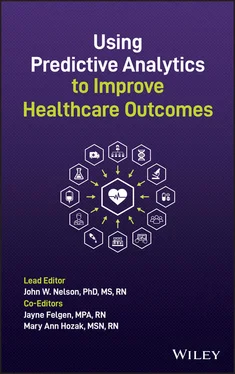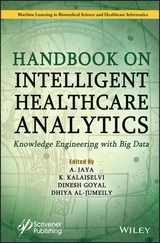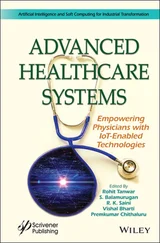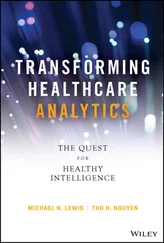Using Predictive Analytics to Improve Healthcare Outcomes
Здесь есть возможность читать онлайн «Using Predictive Analytics to Improve Healthcare Outcomes» — ознакомительный отрывок электронной книги совершенно бесплатно, а после прочтения отрывка купить полную версию. В некоторых случаях можно слушать аудио, скачать через торрент в формате fb2 и присутствует краткое содержание. Жанр: unrecognised, на английском языке. Описание произведения, (предисловие) а так же отзывы посетителей доступны на портале библиотеки ЛибКат.
- Название:Using Predictive Analytics to Improve Healthcare Outcomes
- Автор:
- Жанр:
- Год:неизвестен
- ISBN:нет данных
- Рейтинг книги:5 / 5. Голосов: 1
-
Избранное:Добавить в избранное
- Отзывы:
-
Ваша оценка:
- 100
- 1
- 2
- 3
- 4
- 5
Using Predictive Analytics to Improve Healthcare Outcomes: краткое содержание, описание и аннотация
Предлагаем к чтению аннотацию, описание, краткое содержание или предисловие (зависит от того, что написал сам автор книги «Using Predictive Analytics to Improve Healthcare Outcomes»). Если вы не нашли необходимую информацию о книге — напишите в комментариях, мы постараемся отыскать её.
Discover a comprehensive overview, from established leaders in the field, of how to use predictive analytics and other analytic methods for healthcare quality improvement. Using Predictive Analytics to Improve Healthcare Outcomes
before
proven in advance
Using Predictive Analytics to Improve Healthcare Outcomes
Using Predictive Analytics to Improve Healthcare Outcomes — читать онлайн ознакомительный отрывок
Ниже представлен текст книги, разбитый по страницам. Система сохранения места последней прочитанной страницы, позволяет с удобством читать онлайн бесплатно книгу «Using Predictive Analytics to Improve Healthcare Outcomes», без необходимости каждый раз заново искать на чём Вы остановились. Поставьте закладку, и сможете в любой момент перейти на страницу, на которой закончили чтение.
Интервал:
Закладка:
Alicia House Executive Director Steve Rummler Hope Network Minneapolis, MN, US
Mary Ann Hozak Administrative Director Department of Cardiology St. Joseph’s Health Paterson, NJ, US
Michal Itzhaki Senior Lecturer Department of Nursing Tel Aviv University Tel Aviv, Israel
Benson Kahiu Nurse Manager Mount Sinai Health East Orange, NJ, US
Ayla Kaya Research Assistant Director Pediatric Nursing Akdeniz University Antalya, Turkey
Gay L. Landstrom Senior Vice President and Chief Nursing Officer Trinity Health Livonia, MI, US
Marissa Manhart Performance, Safety, and Improvement Coordinator St. Joseph’s Health Paterson, NJ, US
John W. Nelson Chief Executive Officer Healthcare Environment St. Paul, MN, US
Tara Nichols Chief Executive Officer and Clinician Maters of Comfort Mason City, IA, US
Kenneth Oja Research Scientist Denver Health
Assistant Professor
University of Colorado
Denver, Colorado, US
Dawna Maria Perry Chief Nursing Officer Thunder Bay Regional Health Science Center Thunder Bay, Ontario, Canada
Lance Podsiad Manager Helios Epic
Nurse Manager
Henry Ford Health System
Detroit, Michigan, US
Karen Poole Associate Professor Lakehead University School of Nursing Thunder Bay, Ontario, Canada
Rebecca Smith Writer/Editor Minneapolis, MN, US
Susan Smith Chief Executive Officer Choice Dynamic International Leeds, England
Kay Takes President Eastern Iowa Region of MercyOne Dubuque, IA, US
Patricia Thomas Manager – Associate Dean Nursing Faculty Affairs Wayne State University College of Nursing Detroit, MI, US
Anna Trtchounian Emergency Medicine Resident Good Samaritan Hospital Medical Center West Islip, Long Island, NY, US
Sebin Vadasserril Manager Innovative Nursing Practice and Quality St. Joseph’s Health Paterson, NJ, US
Linda Valentino Vice President Nursing Operations Mount Sinai Hospital New York, NY, US
Dominika Vrbnjak Assistant Professor University of Maribor Faculty of Health Sciences Maribor, Slovenia
Josephine (Jo) Sclafani Wahl Associate Director BRG/Prism MI, US
Jacklyn Whitaker Nurse Manager St. Joseph’s Health Paterson, NJ, US
Theresa Williamson Associate Nurse Director Golden Jubilee National Hospital Clydebank, Scotland
Foreword
John W. Nelson and his colleagues are to be congratulated for creating this distinctive book. A very special feature of the book is the use of predictive analytics to explain, amplify, and validate caring theory. All too often, publications focusing on methods such as predictive analytics ignore the theoretical frameworks that guide the collection of data to which analytics are applied. The reader is then left with the thought, “Perhaps interesting results, but so what?” This book provides the answer to “so what?” by presenting the very interesting results, within the contexts of caring theory, specifically Relation‐Based Care®, the Caring Behaviors Assurance System ©, and Watson’s Theory of Transpersonal Caring.
The book’s content emphasizes quality improvement, which might be considered the most appropriate application of predictive analytics in healthcare. Determining how, when, and why to improve the quality of healthcare, as a way to improve individual‐level and organization‐level outcomes, is a major challenge for all healthcare team members and researchers. Theory‐based predictive analytics is an innovative approach to meeting this challenge.
A challenge for the authors of the chapters of this book, and for its readers, is to determine the most appropriate place for theory in the triad of data, theory, and operations. Given my passion for the primacy of theory, I recommend that the starting point be theory, which determines what data is to be collected and how the data can be applied to operations.
The case studies that make up the several chapters of Sections Two and Four of this book, the contents of which are as interesting as they are informative, help readers to appreciate the value of theory‐based predictive analytics. The case studies, which range from individual‐level problems to department‐level problems to health system‐level problems, underscore the wide reach of theory‐based predictive analytics.
I contend that the ultimate challenge of predictive analytics will be to carry out the theoretical and empirical work needed to test the book editors’ claim, in the Preface of this book, that the same formulas helping people in the trucking and mining industries to create profiles of risk that enable them to prevent unwanted outcomes before they happen, can be applied successfully to improve healthcare outcomes. Meeting this challenge will undoubtedly extend the knowledge of our discipline, which many of us now refer to as nursology (see https://nursology.net).
Jacqueline Fawcett, RN, PhD, ScD (hon), FAAN, ANEF
Professor, Department of Nursing, University of Massachusetts Boston
Management Team Facilitator, https://nursology.net
Preface: Bringing the Science of Winning to Healthcare
A few years before the publication of this book, I attended an international mathematics conference for research in simulation studies and predictive analytics. Out of more than 300 attendees, there was only one other attendee from healthcare. For three days there were presentations by researchers from the fields of logistics (trucking) and mining, reviewing how they used predictive analytics and simulation to proactively manage outcomes related to productivity and company output. Surely, I thought, the same kinds of mathematical formulas presented by the truckers and miners could be used in healthcare to move us from reactive use of data to a proactive approach.
Currently, hospitals evaluate outcomes related to falls and infections using hindsight‐based analytics such as case studies, root cause analyses, and regression analyses, using retrospective data to understand why these outcomes occurred. Once the underlying causes for the outcomes are identified, the organization creates action plans for improving the outcomes. The problem with this process is that retrospective data provides only hindsight, which does nothing to create a profile of current or future risk. Healthcare organizations typically stop short of supporting pro spective management of the data, which would allow for the collection of meaningful data about real‐life trends and what is actually happening in practice right now. Conversely, the truckers and miners at the conference showed how predictive analytics can be used to study risk for the purpose of managing unwanted outcomes before they occur. Since I am both a data scientist and a nurse, I could see clearly that the formulas from the math conference could apply to healthcare; all you would have to do is specify the models.
This book is about how analytics—mostly predictive analytics—can be used to improve outcomes in healthcare. This book also reveals how good data, derived from good theory, good measurement instruments, and good data collection processes has provided actionable information about the patient, the caregiver, and the operations of care, which have in turn inspired structure and process changes that saved millions of dollars while improving the experience of both patients and providers.
Organizations that have embraced predictive analytics as a central part of operational refinement include Amazon, IBM (Bates, Suchi, Ohno‐Machado, Shah, & Escobar 2014), Harrah’s casino, Capital One, and the Boston Red Sox (Davenport 2006). In his 2004 book (and the 2011 film), Moneyball , Michael Lewis, documents an example of how in 2002 the Oakland A’s professional baseball team, which had the lowest payroll in baseball, somehow managed to win the most games. This paradox of winning the most games despite having the skimpiest budget in the league was due to an assistant general manager who used a baseball‐specific version of predictive analytics called sabermetrics to examine what combination of possible recruits would reach first base most reliably, and would therefore result in the team winning the most games. These recruits were not the most obvious players—in fact, they were not considered by almost anyone to be the best players. It was only predictive analytics that made them visible as the right players to comprise this winning team.
Читать дальшеИнтервал:
Закладка:
Похожие книги на «Using Predictive Analytics to Improve Healthcare Outcomes»
Представляем Вашему вниманию похожие книги на «Using Predictive Analytics to Improve Healthcare Outcomes» списком для выбора. Мы отобрали схожую по названию и смыслу литературу в надежде предоставить читателям больше вариантов отыскать новые, интересные, ещё непрочитанные произведения.
Обсуждение, отзывы о книге «Using Predictive Analytics to Improve Healthcare Outcomes» и просто собственные мнения читателей. Оставьте ваши комментарии, напишите, что Вы думаете о произведении, его смысле или главных героях. Укажите что конкретно понравилось, а что нет, и почему Вы так считаете.












